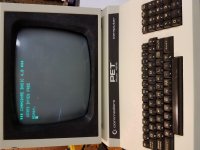KevinO
Experienced Member
Hello all. I could use some guidance from the PET gurus here. Apparently the PETs don't store well, especially in non-temperature controlled environments! My collection had to be stored in a barn for the last 10 months, and they didn't fare well. My good working 8032 had a mouse nest in it!
Anyway, now of my 5 PETs, I now have zero working ones. I brought in my 4016 that the fine folks here helped me fix several years ago, and it's no longer working. I get the expected garbage screen that clears after a second, the startup chirp, then nothing on the screen at all.
Where to start troubleshooting?
Anyway, now of my 5 PETs, I now have zero working ones. I brought in my 4016 that the fine folks here helped me fix several years ago, and it's no longer working. I get the expected garbage screen that clears after a second, the startup chirp, then nothing on the screen at all.
Where to start troubleshooting?

